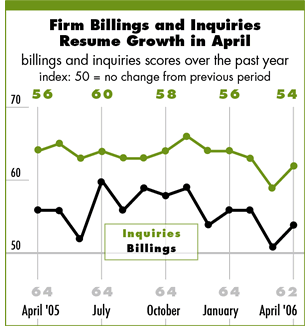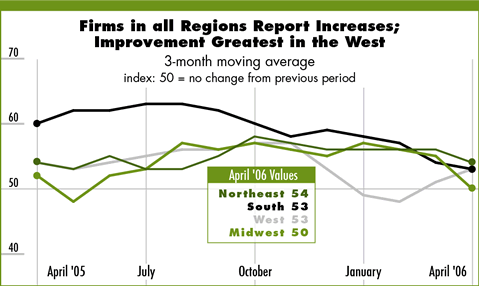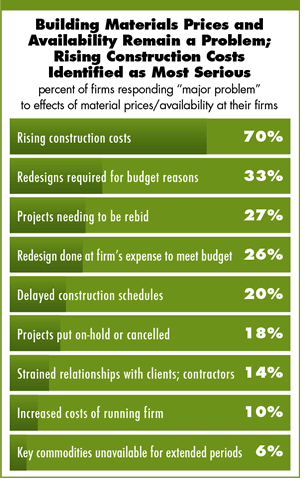

5/2006
Billings, inquiries bounce back; but high materials costs still taking their toll


by Kermit Baker, PhD,
Hon. AIA
Chief Economist
 Billings at architecture firms bounced back in April after remaining
essentially flat in March (after seasonal adjustments). Inquiries for
new projects also moved up, pointing to continued growth in design activity
in the months ahead. Larger firms reported the greatest growth in billings
in April; however, smaller firms reported greater increases in inquiries.
Commercial/industrial firms reported the strongest growth in billings
and inquiries by firm specialization.
Billings at architecture firms bounced back in April after remaining
essentially flat in March (after seasonal adjustments). Inquiries for
new projects also moved up, pointing to continued growth in design activity
in the months ahead. Larger firms reported the greatest growth in billings
in April; however, smaller firms reported greater increases in inquiries.
Commercial/industrial firms reported the strongest growth in billings
and inquiries by firm specialization.
Firms in each of the major regions of the country reported growth in billings in April. Firms in the South have seen their growth decelerate somewhat in recent months. Conversely, firms in the West, which had reported declines in recent months, now see their business levels picking up.
Broader economy chugging along
The broader economy continues to move along at a solid growth pace. Our
gross domestic product grew at a 4.8 percent annual pace during the
first quarter, the strongest quarterly growth rate since the third
quarter of 2003. Business payrolls increased by 138,000 positions nationally
in April, somewhat below the average for the first three months of
the year. Construction payrolls increased by 10,000 positions during
the month and almost 100,000 through the first four months of the year,
and are on a pace to almost match the 300,000 positions added in 2005.

Higher oil prices seem to be taking their toll on consumer sentiment, which dropped sharply with the preliminary May reading after falling slightly in April. Not only are consumers facing rising prices—the consumer price index is increasing at about a 3.5 percent annual pace—so are producers. In fact, producer prices have been growing at an even faster pace.
In an effort to keep inflation in check, the Federal Reserve Board has been pushing up short-term interest rates since the middle of 2004. With another increase in early May, the Federal Funds rate (the rate that the Fed controls) stands at 4.0 percent, which generates a prime lending rate of 7.0 percent. Many analysts feel that the Fed will hold off future rate hikes for a while.
 Materials cost hikes cause problems on projects
Materials cost hikes cause problems on projects
Raw materials for construction have seen a lot of price inflation over
the past several years. Material costs for nonresidential buildings
increased 9.3 percent in 2004, and another 7.4 percent in 2005. Over
the 12 months ending in March 2006, these costs have risen 6.1 percent,
so the rate of growth seems to be moderating at least.
However, when we asked our Work-on-the-Boards panel whether prices and availability of key building material commodities has created problems on projects at their firms in recent months, 31 percent indicated that it had created major problems, with an additional 43 percent indicating minor problems.
Rising construction costs were identified as the key concern stemming from problems with construction materials. That more than 70 percent of respondents are reporting problems on projects at their firms indicates a widespread problem. The need to redesign projects to come in within budget, projects needing to be rebid, and firms needing to spend extra nonbillable time on programming and design to bring projects in within budgets, were each rated as serious problems by between a quarter and a third of these respondents.
Project delays or cancellations were rated as serious by about one in five firms, while strained relationships, higher costs of running the firm, and the unavailability of construction commodities at any price were mentioned less frequently as major problems. Although the rapid inflation in prices of these products is probably behind us, there are few signs that they will be returning to more traditional levels anytime soon.
Copyright 2006 The American Institute of Architects.
All rights reserved. Home Page ![]()
![]()
This month,
Work-on-the-Boards participants are saying:
• Public agency escalation factors are far outpaced by actual market conditions.
Both the design and construction teams are struggling with this basic gap in
funding.
• Material costs are just out of control. For example, a metal building
manufacturer provided a price for their product only after delivery to the jobsite.
• Commercial market is still hot and inquiries are still being received
on multifamily residential.
• In late winter, construction activity looked promising,
but it seems to have tapered off a bit.
![]()